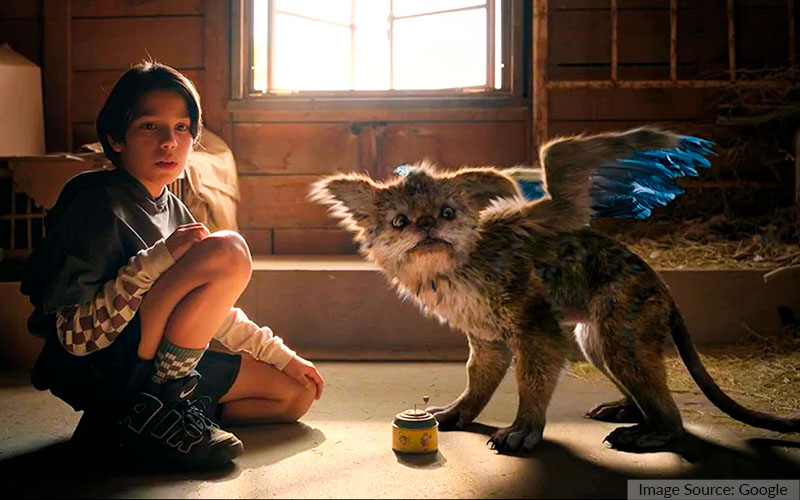Table of Contents
# Unique Features about Chupa’s VFX
# Why does it seem like a challenging project?
# VFX characters require real life inspiration
Chupa, a very popular Netflix film, is about a little child, played by Evan Whitten who makes a mystical chupacabra cub buddy while visiting his extended family in Mexico. The movie, which is directed by Jonás Cuarón and stars Demián Bichir, Christian Slater, Ashley Ciarra, Nickolas Verdugo, and Adriana Paz, is made by Chris Columbus, Mark Radcliffe, and Michael Barnathan. The movie has some amazing digital and in-camera special effects, as one would anticipate from a movie about a legendary beast.
You would be pretty surprised to know that the visual effects of the movie have been a matter of discussion for quite some time. In this article, we will try and dissect that to understand the mechanisms of it.
Unique Features about Chupa’s VFX
The film had anywhere between 350 to 400 shots according to Mitch Drain who was the VFX Supervisor on this movie. He started production on the film in early April 2021. Drain completed his assignment in September 2022.
In an interview, he stated that, in contrast to popular belief, he loved the concept of inventing a monster and its family that seemed like they would actually emerge in nature. The variety of feelings and connections between the main characters made it possible to convey delicate performance qualities through animation, which is something that vfx artists value. This made for an exciting visual effects project for the team and undoubtedly for us to watch as viewers, along with the requirement to create adult variations of the characters, a fully realized mountain lion, and large scale locations.
Why does it seem like a challenging project?
As with any CGI or photorealistic character, there were undoubtedly many difficulties. The director, Jonas Cuaron, and writer Mitch Drain decided early on in the concept stage that they wanted a likable character who could maybe exist, concealed from our reality. The “Chupa” team always anticipated that it would appeal to kids, but they intended to steer clear of any needless cuteness or cliche design choices. Students who learn VFX in Kolkata often remark that challenges make a project’s depth more interesting to its team.
Chupa is a cute character, but its makers tried to maintain it in line with nature, much like how a puppy, kitten, or other juvenile animal is cute. They also required a flying creature that had some degree of plausibility. Fur and feathers, two materials that are notoriously challenging to authentically reproduce, had to coordinate with one another.
VFX characters require real life inspiration
The VFX team and directors looked at a variety of creatures and tried to combine their traits to create a new species. When you learn animation in Kolkata, the choosing of character’s inspiration from existing creatures is taught. Short term courses like creature animation are specialized training programs dedicated to the same.
They had to make sure it wasn’t a dog or cat, a squirrel, a koala, a bear, or anything else too recognizable. Wolverines, foxes, meerkats, and a variety of other animals with comparable physical characteristics were studied by the storyboard artists! It was always the intention for the wings to exude majesty. Later, Drain and his colleagues used the outline of an eagle’s wing as a starting point and included macaw and other vibrant south American parrots’ colours. The director aimed for an iridescent sheen that, like a black crow’s wings, would disclose pinks and turquoise under specific lighting situations.
Most Remarkable VFX generated moments in Chupa
The scene where Alex and Chupa first encounter each other in the barn was extremely popular with viewers. The scene transitions from a soft end-of-day light to a stormy night with only a lantern for light. It seems lovely. Without resorting to over the top, cartoonish animation cliches, Matt Glover, Art Curry, and his team of animators had the opportunity to really demonstrate their talent for expressing emotion and feelings.
Students pursuing VFX or animation courses often discuss the following scene. The view over the canyon would come in second. The enlarged setting required a lot of labor, much more than the viewer would ever be able to tell. Along with the excitement involving the mountain lion and realistic stunts, the sequence features a lovely interaction between Alex and Chupa.
What were the VFX tools utilised in this project?
According to the VFX Supervisor, Mitch Drain, they utilised Nuke, Maya and Houdini for compositing. Additionally, they had to utilise Flame for some quick turnarounds and frame specific re-times.
You can learn these tools in VFX and animation courses in Kolkata. There is scope to professionally master these tools in these courses. As a result, someday you would be capable of creating characters like these on your own.
For free counseling on how to take admission, learn and master these courses, you can reach out to us. We will set up a 1:1 counseling session with an education expert for you.

